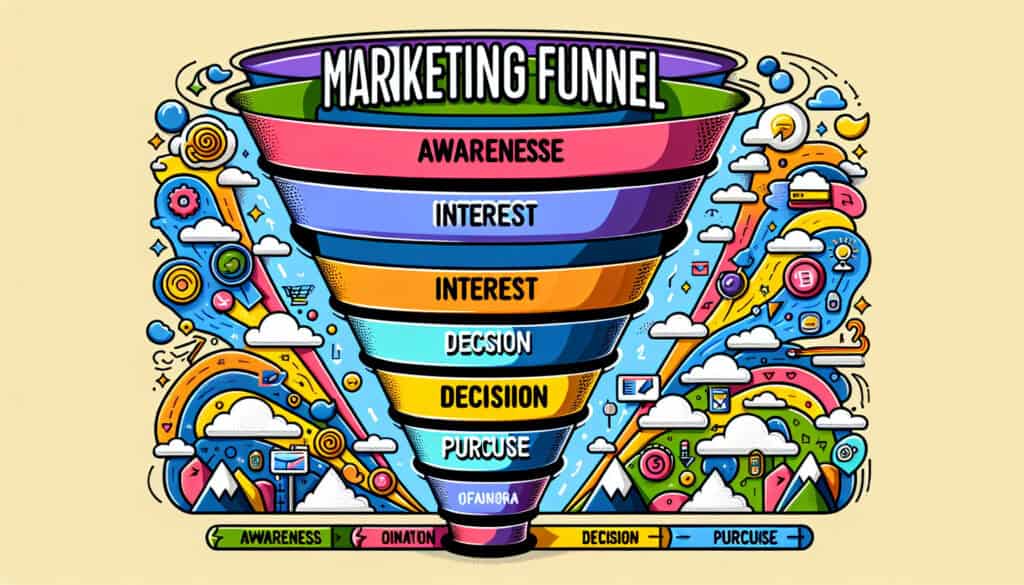Visualizar el recorrido del cliente desde el conocimiento hasta la compra.
- Metodologías: Economía, Ingeniería, Calidad
Embudo de marketing

Embudo de marketing
- Tasa de conversión, Experiencia del cliente, Trayectoria del cliente, Marketing, Estrategia de comercialización, Experiencia de usuario (UX), Diseño centrado en el usuario, Propuesta de valor, Mapeo del flujo de valor
Objetivo:
Cómo se utiliza:
- Modelo que ilustra el recorrido teórico del cliente hacia la compra de un bien o servicio. El embudo se divide en varias etapas, como concienciación, interés, consideración y conversión.
Ventajas
- Proporciona una forma sencilla e intuitiva de comprender el recorrido del cliente; ayuda a identificar las áreas en las que los clientes abandonan.
Contras
- Puede ser demasiado simplista y no reflejar la naturaleza no lineal del recorrido del cliente; se centra más en la captación que en la retención.
Categorías:
- Clientes y marketing
Ideal para:
- Comprender y optimizar el recorrido del cliente para aumentar las tasas de conversión.
Applications of the Marketing Funnel can be found across numerous sectors, including technology, retail, healthcare, and education, where understanding consumer behavior is paramount for driving sales and enhancing customer experiences. Typically utilized during the product development and marketing phases, this model encourages teams to examine each stage in depth, offering a clearer view of where strategic adjustments can increase buyer engagement and conversion rates. For instance, in the tech industry, a product team may employ the funnel model to analyze how potential users first learn about a new app, the content that piques their interest, and the factors influencing their decision-making process before committing to download. Participants in this exercise often include marketing strategists, product managers, and UX designers, all working collaboratively to establish effective communication and marketing strategies at each stage. The simplicity of the funnel allows stakeholders to visualize customer interactions effectively, revealing specific drop-off points—such as a website’s checkout page—where potential consumers lose interest, enabling targeted improvements that can significantly boost sales performance. By integrating analytics tools with the funnel methodology, organizations gain quantitative data that can refine campaigns and enhance user outreach across various platforms.
Pasos clave de esta metodología
- Defina segmentos de público objetivo en función de sus características demográficas y su comportamiento.
- Desarrollar estrategias de sensibilización a través de diversos canales de marketing.
- Cree contenidos atractivos que capten el interés y establezcan una relación con los clientes potenciales.
- Aplique tácticas que faciliten la toma en consideración, como comparaciones de productos y estudios de casos.
- Optimice la conversión mediante llamadas a la acción eficaces y procesos de compra simplificados.
- Analice la experiencia posterior a la compra para fomentar la repetición de la compra y las recomendaciones.
Consejos profesionales
- Aproveche el análisis de datos para supervisar continuamente las tasas de conversión en cada etapa e identificar los puntos de abandono para una intervención específica.
- Realice pruebas A/B en varias fases para perfeccionar los mensajes, los elementos visuales y las llamadas a la acción que más resuenen entre los clientes.
- Utilice los bucles de comentarios de los clientes después de la compra para comprender su experiencia e informar de las mejoras iterativas en las etapas del embudo.
Leer y comparar varias metodologías, recomendamos el
> Amplio repositorio de metodologías <
junto con otras más de 400 metodologías.
Sus comentarios sobre esta metodología o información adicional son bienvenidos en la dirección sección de comentarios ↓ , así como cualquier idea o enlace relacionado con la ingeniería.
Contexto histórico
1910
1957
1960
1980
1980
1986
1990
1994
1950
1957
1970
1980
1983
1990
1992
(si se desconoce la fecha o no es relevante, por ejemplo "mecánica de fluidos", se ofrece una estimación redondeada de su notable aparición)















Publicaciones relacionadas
Cuestionarios sobre molestias musculoesqueléticas
Pruebas multivariantes (MVT)
Análisis de regresión múltiple
Sistemas de captura de movimiento
Método MoSCoW
Prueba de la mediana de Mood